L.T.E. has inaugurated a new fully electric coating plant in compliance with the Net Zero guidelines, designed and installed by Visa Impianti. This marks a significant evolution in its journey towards increasingly efficient and sustainable production, in line with the principles of the Toyota Production System. The system is the result of a synergy among Italian suppliers of excellence: CMA Robotics provided the self-learning robot, Futura the power&free conveyor, OMSG the sandblasting system, Gema the MagicCylinder booth, and Sherwin-Williams the coating products.
Zero Muda.
A Japanese phrase that can be translated as ‘zero waste’ but actually encompasses a much deeper philosophy. It is one of the founding principles of the Toyota Production System (TPS), an organisational and production model that aims to systematically eliminate everything that does not create value for the customer. It is about minimising unnecessary consumption, avoiding waste, and optimising every production step. Above all, it entails taking care of resources – materials, energy, and people – with intelligence and respect to build a more efficient, streamlined, and sustainable industrial ecosystem. At a time when the climate crisis is forcing a paradigm shift, the concepts of efficiency and sustainability must go hand in hand. Today, sustainability does not just mean reducing emissions or choosing renewable energy: it requires rethinking every single design and operational decision regarding environmental and social impact.
“As solution manufacturers and providers, we are called upon to identify every opportunity for improvement within our own processes and those of our customers. We do this by monitoring data, preventing waste, managing energy efficiently, and actively seeking low-carbon alternatives. This is the approach that guides our innovation: creating smart processes that enable more conscious use of resources and reduce dependence on fossil fuels by favouring green and high-performance solutions. This path is also built on solid partnerships and a shared industrial vision,” says Elisa Cavallina, Process Engineering Maintenance & TPS Manager at L.T.E.
A long-standing manufacturing company belonging to the Toyota Material Handling Europe Group, L.T.E. has been applying the principles of the Toyota Production System at its plant in Ostellato (Ferrara, Italy) for many years. Attention to quality, efficiency, and sustainability is an integral part of its production process. Precisely with the aim of reducing its environmental impact, optimising the management of resources, and limiting the use of methane gas, L.T.E. has chosen to rely once again on Visa Impianti (Tregasio di Triuggio, Monza e Brianza, Italy) for the design and construction of a fully electric powder coating plant. Installed in its new Fork Carriage Business Unit to treat fork carriages and load-bearing grids, this perfectly aligns with the Zero Muda and TPS principles.
A lean, innovation-oriented approach at the service of the material handling industry: the story of L.T.E.
Founded in Milan in 1976 as a manufacturer of special lifting units for forklift trucks, L.T.E. Lift Truck Equipment S.p.a. immediately distinguished itself for its high level of specialisation in designing and manufacturing masts and, above all, its ability to produce customised versions with the same quality standards as mass production. That enabled it to quickly gain recognition as an OEM (Original Equipment Manufacturer) from several leading international forklift truck manufacturers.
Subsequently relocated to the SIPRO industrial area in San Giovanni di Ostellato, where it now operates within a production area of 100,000 m² with a workforce of 665 employees, L.T.E. experienced a strategic turning point in 2005 with its entry into the Toyota Material Handling Group (TMHG), a world leader in the sector. A year later, the adoption of the TPS marked a change of pace in the company’s production management, introducing the principles of continuous improvement, waste reduction, and process standardisation, which led to a significant structural evolution. In the last few years, L.T.E. has organised its activities into three dedicated business units – masts, lifting cylinders, and fork carriages – to further improve processes, quality, and traceability.
Cavallina explains: “In recent years, we have focused heavily on automation and line optimisation, not only to increase productivity but also to improve ergonomics and reduce our quality defect rate.” That is why the company is currently exploring advanced solutions such as AGVs (Automated Guided Vehicles) and MRs (Mobile Robots) and, at the same time, collaborating with technology partners to digitalise its internal processes through advanced synoptic interfaces and MES systems, integrated to reduce manual input in inspection and maintenance activities and make production control increasingly predictive and data-driven.
As regards the coating process, the latest innovation implemented was installing a Giotto plant, a fully electric automatic coating line that has improved L.T.E.’s finishing operations and coating quality while enabling an essential step towards sustainability and efficiency in production.
The production cycle of fork carriages and load-bearing grids
The production cycle carried out in the Fork Carriage Business Unit at the Ostellato site stands out for its highly integrated and quality-oriented approach. L.T.E., which manufactures products exclusively for other Toyota Material Handling Europe (TMHE) Group companies with production plants in Sweden, France, and Italy, begins its workflow by receiving raw materials from its suppliers. These are then subjected to various machining processes and sent to one of the 3 welding lines that the new Business Unit has at its disposal.
“The metalworking phase includes several steps: spot welding is carried out initially, followed by welding, which is performed with robots on approximately 92% of products and done manually on special and low-volume products. Afterwards, finishing and straightening operations are performed to ensure the geometric conformity of components. The load-bearing grids are only spot welded and welded after machining and before coating, a crucial step for the aesthetics and functional protection of parts. Some of our products are used in particularly aggressive environments, such as cold rooms or areas with high exposure to salt, so the metal must be entirely and permanently covered,” indicates Fork Carriages Plant Process Engineer Luca Bagatella.
After coating, the parts are sent to the Mast Business Unit’s assembly line, where they are matched with masts and then tested and checked before being shipped to L.T.E.’s customers.
The Giotto coating line
The new coating plant, operational since January 2025, has been designed to powder coat the fork carriages and load-bearing grids produced at the Ostellato plant, as well as ensuring business continuity for masts, which are coated by the Mast Business Unit.
It is a fully automatic line, and its loading area is equipped with an automatic lowerator that picks up the components from trolleys positioned by the operators.
The parts are then moved along the line by a power & free conveyor designed by Futura (Robecco Pavese, Pavia, Italy) and taken to a Tunnelblast 1016/8 automatic in-line turbine shot blasting machine from OMSG (Villa Cortese, Milan, Italy), which prepares their surfaces to coating by finishing them to an SA 2½ degree.
Following surface preparation, the components pass through a manual blow-off station to remove any residual grit and then follow one of two possible paths, one including the application of a primer – an option reserved for a small number of parts – and one that takes them directly to the finishing application booth.
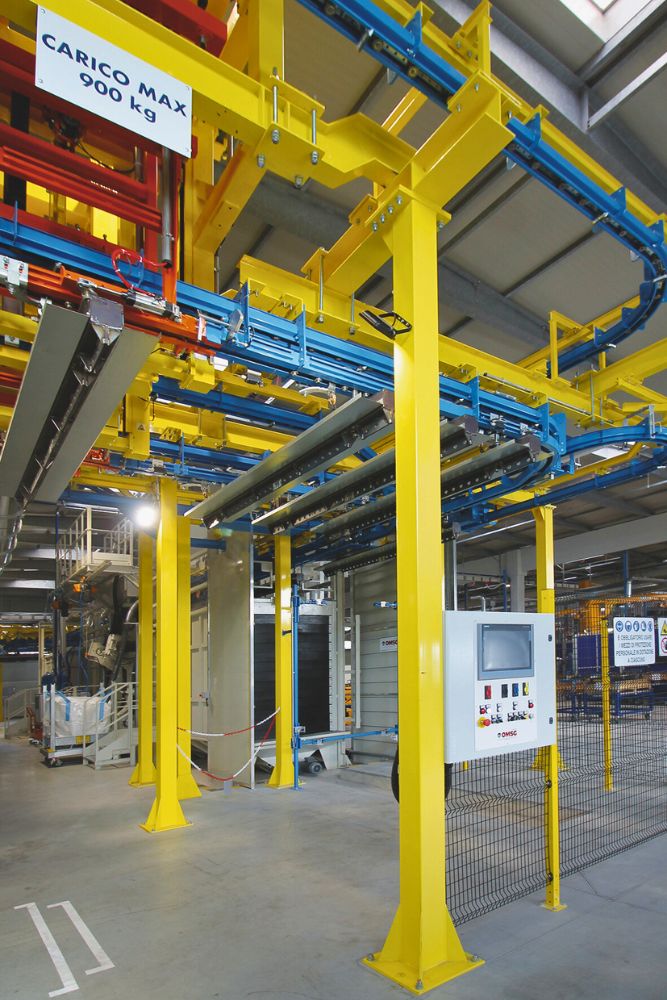 The loading area is equipped with an automatic lowerator that picks up the components from trolleys positioned by the operators. © ipcm
The loading area is equipped with an automatic lowerator that picks up the components from trolleys positioned by the operators. © ipcm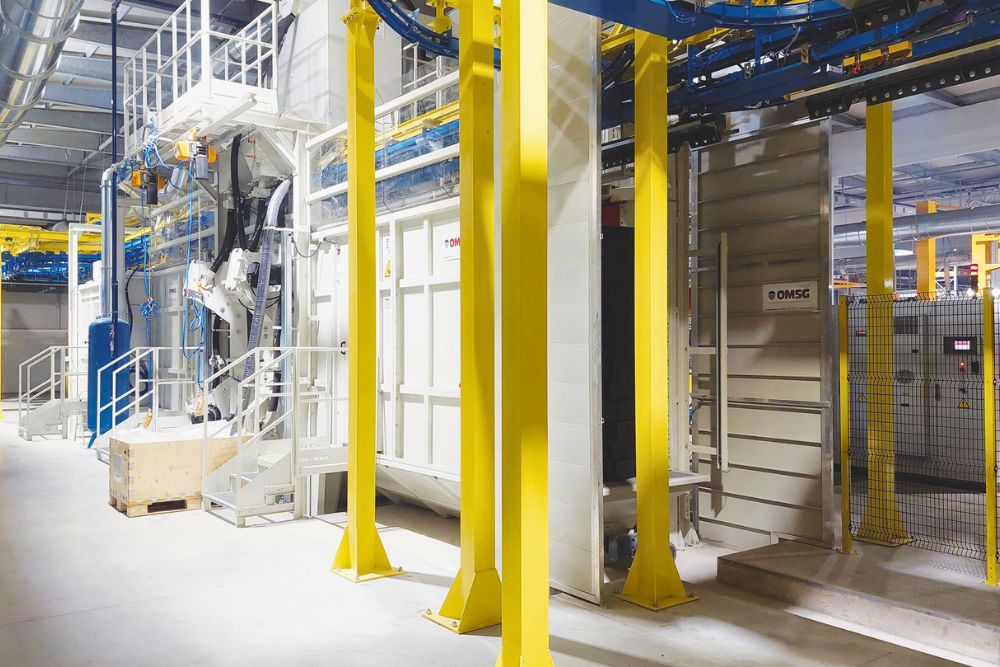 The Tunnelblast shot blasting machine installed by OMSG. © L.T.E.
The Tunnelblast shot blasting machine installed by OMSG. © L.T.E.“In the case of two-coat application cycles, the components are taken to the manual primer application booth and then pass through a gelling oven with IR panels,” illustrates Paolo Massari, the owner of Visa Impianti.
However, most components reach directly to the top coat application booth, which is fully automated and equipped with a robot from CMA Robotics (Pavia di Udine, Udine, Italy) that performs a pre-finishing phase and 2 reciprocators with 8 automatic guns from Gema (Trezzano sul Naviglio, Milan), i.e. 4 on each side, using conventional Venturi technology for powder feeding.
“Together with Visa Impianti, which handled the integration phases, we provided a powder application system for pre-finishing operations using our GR 680 articulated robot. This solution stands out for its innovative VRT (Virtual Reality Tracking) programming system, which makes it possible to combine manual powder pre-finishing on complex objects with perfect repeatability guaranteed by the use of a robot,” says Marco Zanor, the owner of CMA Robotics.
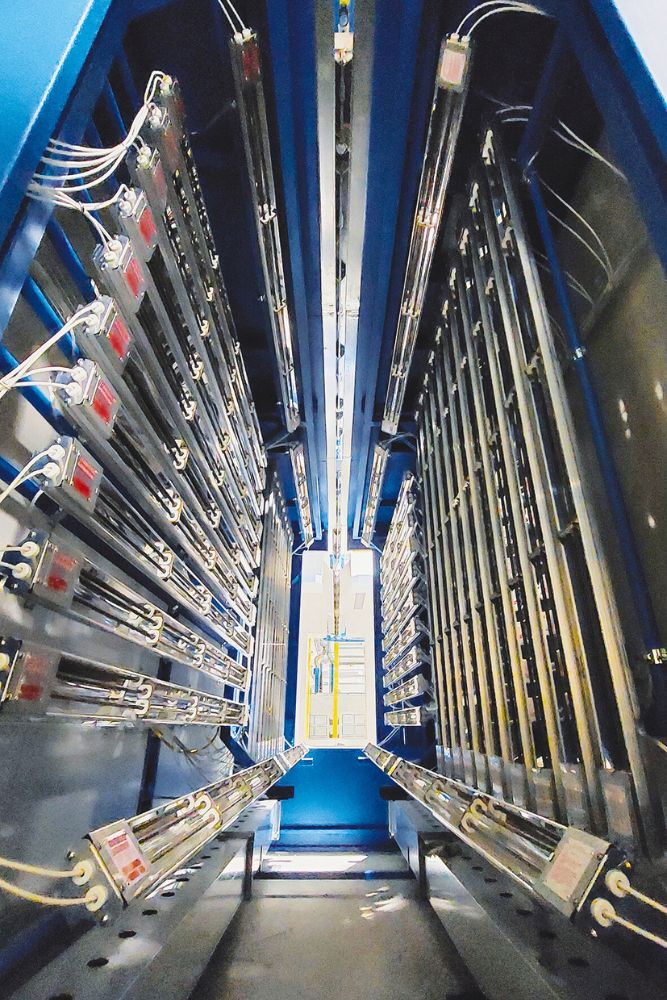 After primer application, the components pass through a gelling oven with IR panels. © L.T.E.
After primer application, the components pass through a gelling oven with IR panels. © L.T.E.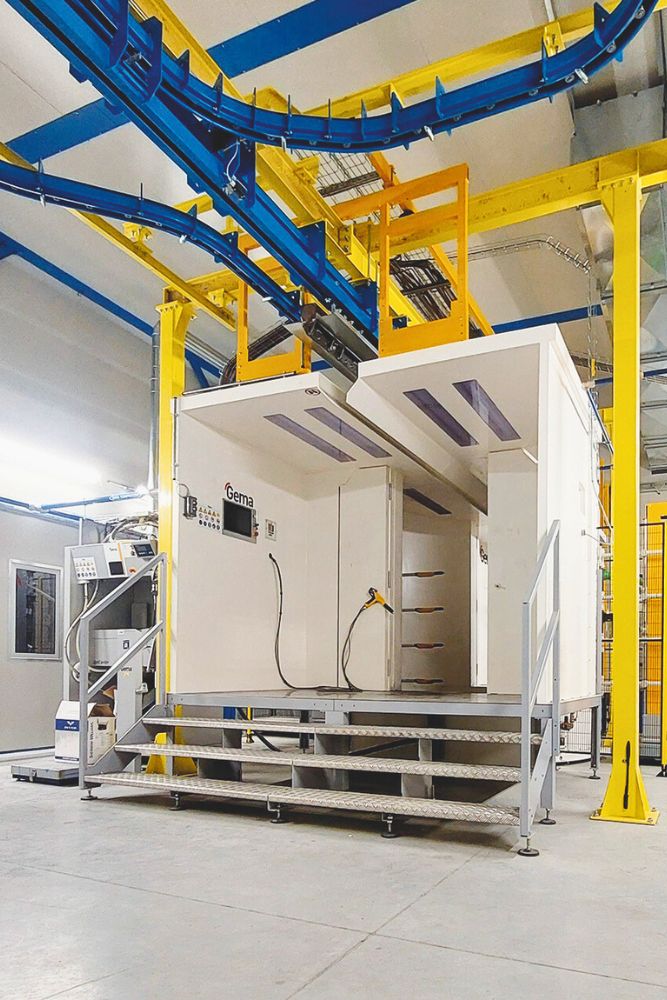 Overview of the MagicCylinder® coating booth from Gema. © L.T.E.
Overview of the MagicCylinder® coating booth from Gema. © L.T.E.“The MagicCylinder® booth from Gema is installed inside a temperature-controlled clean room and features a cyclone system and an Opticenter powder centre optimising powder recovery and management. The system also automatically controls the dispensing and safe disposal of spent filters in big bags, avoiding any direct contact between the operators and the powder products,” notes Francesco Maria Cavedagna, the Process & Manufacturing Engineering Coordinator of the Masts Business Unit at L.T.E. “At the moment, we only use a black thermosetting polyester powder supplied by Sherwin-Williams (Bologna, Italy), but the booth is set up for colour change operations in anticipation of future production developments and colour customisation requirements.”
The cycle ends with the curing phase in a bell oven, followed by forced cooling with a dedicated chiller. Mirroring the loading station, the unloading station has a second automatic lowerator that allows the components to be repositioned on the trolleys, ready to be sent to the company’s 21 assembly stations.
“The line is also equipped with a part recognition system that automatically selects the right coating cycle, distinguishing between one- and two-coat processes with an integrated on/off switch mechanism for the primer application booth. Finally, a volumetric reading radar is also being implemented, which will analyse the parts’ profiles for the robot to adapt its coating path in real time,” adds Rudy Zaramella, Operations Director at L.T.E.
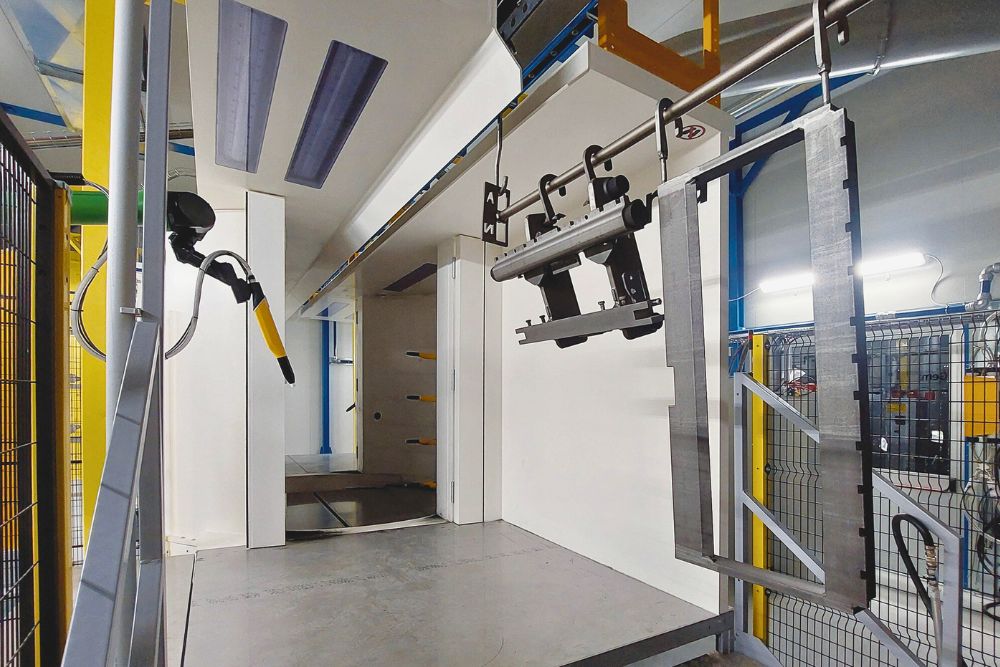 The CMA Robotics robot performs a pre-finishing operation. © L.T.E.
The CMA Robotics robot performs a pre-finishing operation. © L.T.E.The need for a fully electric coating plant
“L.T.E. had identified the coating phase, an energy-intensive process traditionally dependent on fossil fuels such as gas, as one of the most critical areas to be improved to reduce the environmental impact of its industrial activities,” says Zaramella. Last year, aware of the growing need to address these challenges, the company turned to Visa Impianti to build a coating plant powered entirely by electricity, without using fossil fuels. This choice was not only a response to the need to reduce greenhouse gas emissions but also marked a concrete step towards building a more sustainable production model, in line with Toyota Material Handling’s overall strategy.
L.T.E. has been implementing a series of measures to reduce its environmental impact for several years now, with the ambitious goal of achieving net-zero greenhouse gas emissions by 2041 and eliminating the use of gas in its plants by 2050. “Installing this system was not only a technical milestone but also a testament to our commitment to sustainability. Opting for a fully electric line goes far beyond simply reducing consumption. It is a strategic choice part of a long-term vision aimed at our Group’s decarbonisation and energy transition, a crucial step towards an increasingly green and self-sufficient industrial future,” continues Zaramella.
Another aspect that makes this line even greener is the use of solar panels, which partially power its devices.
Design and process validation challenges
“At the start of the project, we provided Visa Impianti with precise data to be adhered to: daily production over two shifts, 880 minutes of actual work per day, a target of 210 painted products per day, and a maximum takt time of 2 minutes and 45 seconds,” states Elisa Cavallina. The real challenge, however, was logistical: “We had to fit the entire plant into the existing hall while ensuring a streamlined, compact layout with no waste – Zero Muda, even in terms of space.” Despite structural constraints, the new plant has been designed to meet the initial production requirements while also covering up to 30% of the mast production, thus becoming a strategic backup solution for the other line built by Visa Impianti in 2008.
This project was an important milestone for both companies: it was the first fully electric plant to be installed and started up, resulting from meticulous design activities and state-of-the-art technological solutions. “As regards the coating process validation protocol, we have conducted a series of quality checks in recent months to ensure compliance with our customer specifications. In particular, we have constantly monitored the thickness of the paint film, ensuring it remained within the specified range, and carried out checks on its gloss level. The tests also included the ‘Grant’ test, which verifies the coating’s curing results, and the salt spray test, essential for assessing corrosion resistance. Both tests were carried out on all the possible application cycles, i.e. the standard process with the application of the top coat alone and the more complex process that also involves the application of the primer (for which we are awaiting the final results). At the same time, we consolidated specific recipes for each product type and range through joint work with the operators who validated every process stage. This approach inevitably took longer to reach full production capacity, but it now guarantees that every part delivered is 100% compliant with the expected quality standards,” states Alessia Rossetti, Quality Process Engineer at L.T.E.
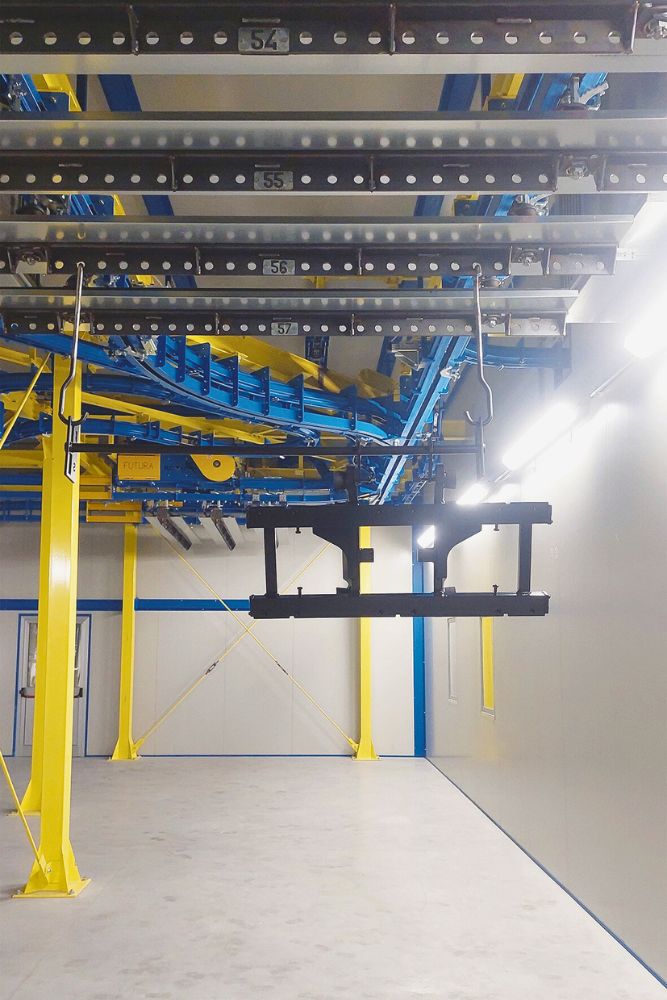 Components entering the oven. © ipcm
Components entering the oven. © ipcm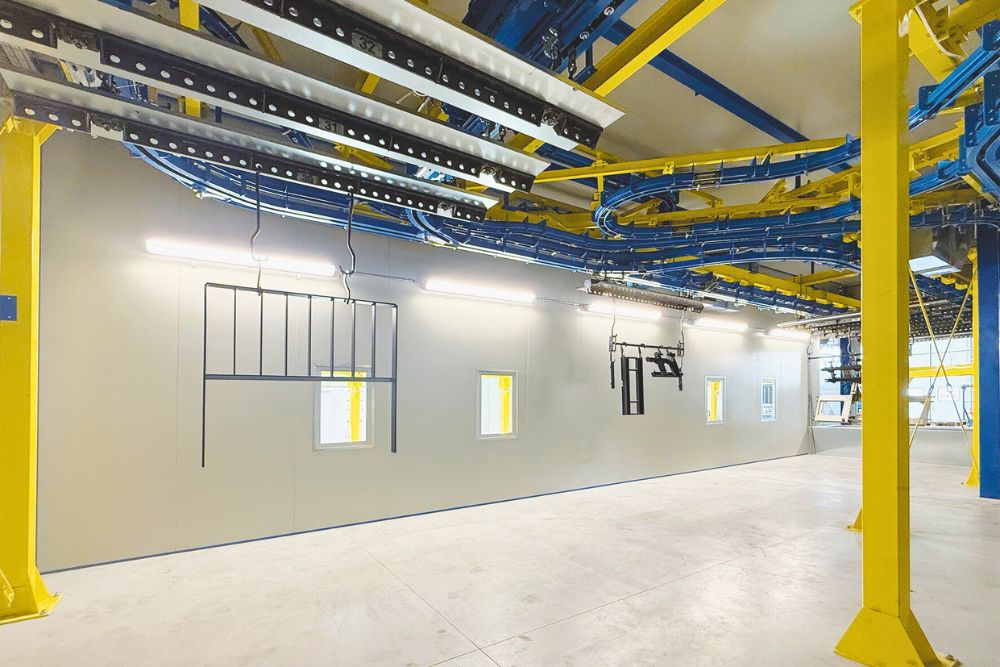 The post-curing storage buffer. © ipcm
The post-curing storage buffer. © ipcmTowards leaner and greener production: the success of this project
The advantages brought by the new coating plant designed and installed by Visa Impianti have undoubtedly included a significant reduction in energy consumption, which has led to increased efficiency and a considerably lower environmental impact. Recent analyses have shown that, at full capacity (excluding the IR oven used only for specific components), the plant’s energy requirement is 280 kWh, an extremely low figure compared to conventional plants. It has a 50-60% lower electricity consumption than the mast powder coating line, powered by traditional technologies. The improvement in efficiency is also reflected in the use of resources: while the mast coating line requires an average of 6 operators, the new fork carriage coating system only requires 2 people assisted by a supervisor.
The success of this project was also made possible by L.T.E.’s solid partnership with Visa Impianti, which has been consolidated over time since the first plant was installed in 2008.
“We are extremely pleased with the objectives achieved with this new line. Visa Impianti has always proven a reliable and responsive partner, able to offer prompt support even with unexpected needs,” says Zaramella.
The collaboration between the two companies was not limited to the installation phase: in full accordance with the TPS principles, this is followed by a continuous fine-tuning phase aimed at identifying areas for refinement in line with the principle of Kaizen, or continuous improvement. “As a Toyota company, we place great emphasis on training our people and also value the training provided directly by our suppliers to line operators, which is essential for achieving an increasingly industrialised and optimised process.”
This project also marked a significant milestone for Visa Impianti: “Working with a company like L.T.E. is an honour, and contributing to the creation of the first fully electric coating plant is a source of great pride for us,” concludes Paolo Massari from Visa Impianti.
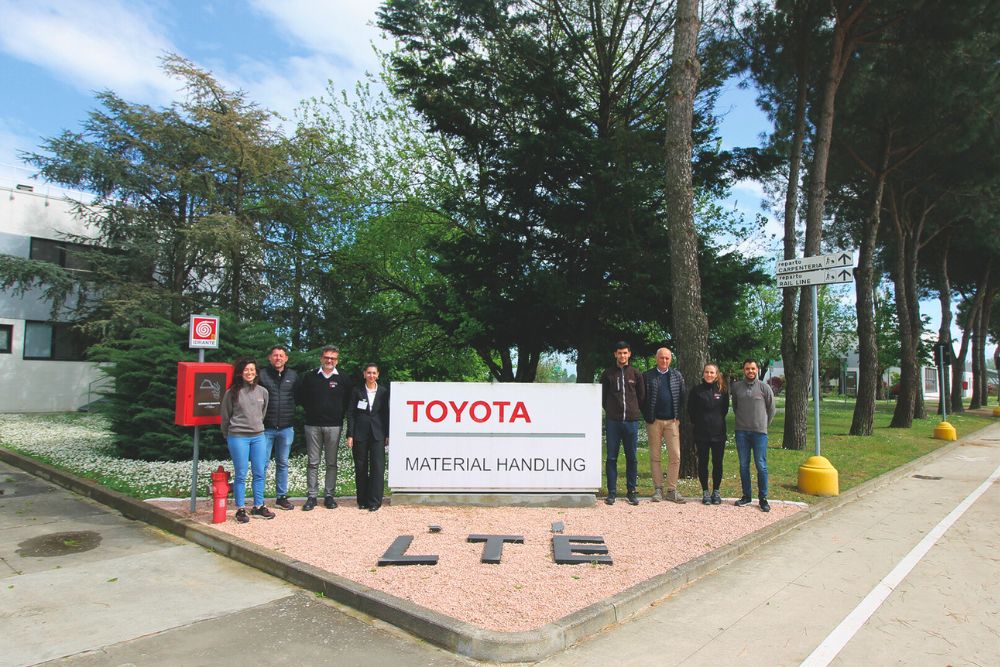 The L.T.E. team together with Visa Impianti owner Paolo Massari and Ilaria Paolomelo from ipcm®. © ipcm
The L.T.E. team together with Visa Impianti owner Paolo Massari and Ilaria Paolomelo from ipcm®. © ipcm